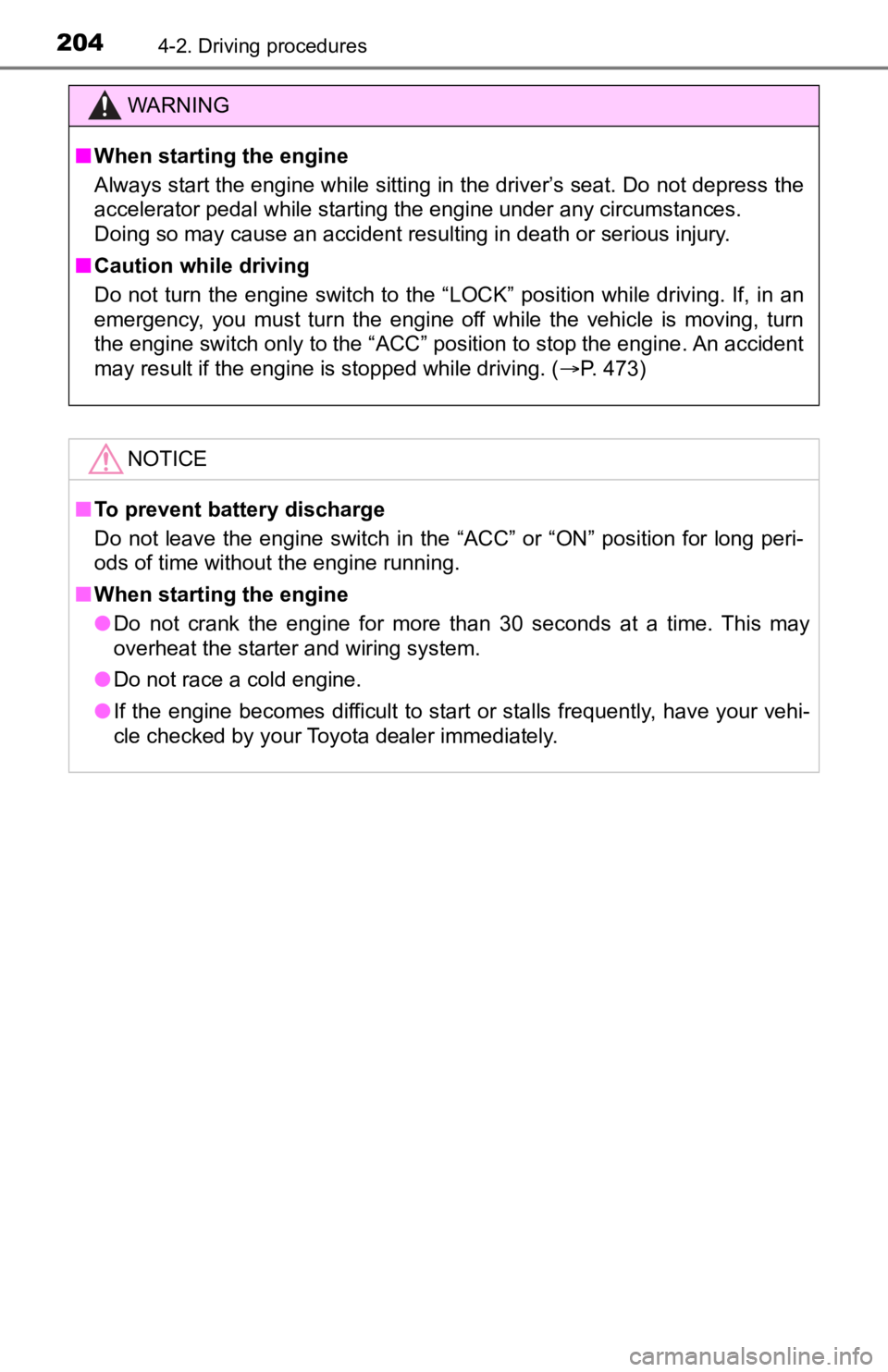Page 188 of 616
1884-1. Before driving
Double Cab models
*1: The model code is indicated on the Certification Label. (P. 543)
■Unbraked TWR*
1000 lb. (450 kg)
■Fifth wheel and gooseneck towing TWR*
Toyota does not recommend fifth wheel and gooseneck towing.
Model code*1EngineDriving
systemGCWRTWR
TRN265L-PRTSKA 2TR-FE
engine
2WD7870 lb.
(3565 kg) 3500 lb.
(1590 kg)
GRN325L-PRTSHA
2GR-FKS engine 11300 lb.
(5125 kg)
6700 lb.
(3040 kg)
GRN325L-PRTLHA 11250 lb.
(5100 kg)6600 lb.
(2995 kg)
GRN330L-PRTSHA 11240 lb.
(5095 kg)6600 lb.
(2995 kg)
GRN330L-PRTLHA 11290 lb.
(5120 kg)6600 lb.
(2995 kg)
GRN305L-PRFSHA
4WD11260 lb.
(5105 kg)
6400 lb.
(2900 kg)
GRN305L-PRTSHA 11240 lb.
(5095 kg)6400 lb.
(2900 kg)
GRN305L-PRTLHA 11300 lb.
(5125 kg)6400 lb.
(2900 kg)
GRN310L-PRTSHA 11290 lb.
(5120 kg)6400 lb.
(2900 kg)
GRN310L-PRTLHA 11040 lb.
(5005 kg)6000 lb.
(2725 kg)
*: These models meet the tow-vehicle trailering requirement of SAE
International per SAE J2807.
Page 194 of 616

1944-1. Before driving
●Slow down before making a turn, in crosswinds, on wet or slippe ry
surfaces, etc.
Increasing vehicle speed can destabilize the trailer.
● Take care when passing other vehicles. Passing requires consider-
able distance. After passing a vehicle, do not forget the lengt h of
your trailer, and be sure you have plenty of room before changi ng
lanes.
● Vehicles with an automatic transmission: To maintain engine bra k-
ing efficiency and charging system performance when using engin e
braking, do not use the transmission in D. If in the S mode, th e
transmission shift range posit ion must be in 5 or lower.
● Vehicles with a manual transmiss ion: To maintain engine braking
efficiency and charging system performance when using engine
braking, do not use the sixth gear.
● Instability happens more frequently when descending steep or lo ng
downhill grades. Before descending, slow down and downshift. Do
not make sudden downshifts while descending steep or long down-
hill grades.
● Avoid holding the brake pedal down too long or applying the bra kes
too frequently. This could cause the brakes to overheat and result in
reduced braking efficiency.
● Due to the added load of the trailer, your vehicle’s engine may over-
heat on hot days (at temperatures over 85°F [30°C]) when drivin g
up a long or steep grade. If the engine coolant temperature gau ge
indicates overheating, immediately turn off the air conditionin g (if in
use), pull your vehicle off the road and stop in a safe spot.
( P. 534)
Page 195 of 616

1954-1. Before driving
4
Driving
●Always place wheel blocks under both the vehicle’s and the trai ler’s
wheels when parking. Apply the parking brake firmly, and put th e
transmission in P (automatic transmission) or in 1 or R (manual
transmission). Avoid parking on a slope, but if unavoidable, do so
only after perform ing the following:
Apply the brakes and keep them applied.
Have someone place wheel blocks under both the vehicle’s and
trailer’s wheels.
When the wheel blocks are in pl ace, release the brakes slowly
until the blocks absorb the load.
Apply the parking brake firmly.
Shift into P (automatic transmission) or 1 or R (manual transmi s-
sion) and turn off the engine.
● When restarting afte r parking on a slope:
With the transmission in P (autom atic transmission) or the clutch
pedal (manual transmission) depr essed, start the engine. On
vehicles with an automatic transmission, be sure to keep the
brake pedal pressed.
Shift into a forward gear. If reversing, shift into R.
Release the parking brake (and also the brake pedal on vehicles
with an automatic transmission), and slowly pull or back away
from the wheel blocks. S top and apply the brakes.
Have someone retrieve the blocks.
1
2
3
4
5
1
2
3
4
Page 197 of 616

1974-1. Before driving
4
Driving
■When towing a trailer
Disable the following systems, as the systems may not operate p roperly.
● LDA (Lane Departure Alert with Yaw Assist Function) (if equippe d)
( P. 258)
● Dynamic radar cruise control (if equipped) ( P. 266)
● Cruise control (if equipped) ( P. 280)
● BSM (Blind Spot Monitor) (if equipped) ( P. 292)
● Intuitive parking assist (if equipped) ( P. 284)
● RCTA (Rear Cross Traffic Alert) function (if equipped) ( P. 292)
■ Break-in schedule
If your vehicle is new or equipped with any new power train com ponents
(such as an engine, transmission, differential or wheel bearing ), Toyota rec-
ommends that you do not tow a trailer until the vehicle has bee n driven for
over 500 miles (800 km).
After the vehicle has been driven for over 500 miles (800 km), you can start
towing. However, for the next 500 miles (800 km), drive the veh icle at a speed
of less than 50 mph (80 km/h) when towing a trailer, and avoid full throttle
acceleration.
■ Maintenance
●If you tow a trailer, your vehicle will require more frequent m aintenance due
to the additional load. (See “Owner’s Warranty Information Book let” or
“Scheduled Maintenance Guide”/“Owner’s Manual Supplement”.)
● Retighten the fixing bolts of the towing ball and bracket after approximately
600 miles (1000 km) of trailer towing.
Page 202 of 616
2024-2. Driving procedures
Engine (ignition) switch (vehicles without a
smart key system)
Automatic transmission
Check that the parking brake is set.
Check that the shift lever is set in P.
Firmly depress the brake pedal.
Turn the engine switch to the “S TART” position to start the engine.
Manual transmission
Check that the parking brake is set.
Check that the shift lever is set in N.
Firmly depress the clutch pedal.
Turn the engine switch to the “S TART” position to start the engine.
“LOCK”
The steering wheel is locked and
the key can be removed. (Vehicles
with an automatic transmission:
The key can be removed only
when the shift lever is in P.)
“ACC”
Some electrical components such
as the audio system can be used.
“ON”
All electrical components can be used.
“START”
For starting the engine.
Starting the engine
Changing the engine switch positions
1
2
3
4
1
2
3
4
1
2
3
4
Page 203 of 616
2034-2. Driving procedures
4
Driving
■Turning the key from “ACC” to “LOCK”
Shift the shift lever to P (automatic transmission) or N (manua l transmis-
sion).
■ If the engine does not start (vehicles with engine immobilizer system)
The engine immobilizer system may not have been deactivated. ( P. 78)
Contact your Toyota dealer.
■ When the steering lock cannot be released
■ Key reminder function
A buzzer sounds if the driver’s door is opened while the engine switch is in
the “ACC” or “LOCK” position to remind you to remove the key. Push in the key and turn it to the
“LOCK” position.
When starting the engine, the engine
switch may seem stuck in the “LOCK”
position. To free it, turn the key while turn-
ing the steering wheel slightly left and
right.
1
2
Page 204 of 616

2044-2. Driving procedures
WARNING
■When starting the engine
Always start the engine while sitting in the driver’s seat. Do not depress the
accelerator pedal while starting the engine under any circumstances.
Doing so may cause an accident resulting in death or serious in jury.
■ Caution while driving
Do not turn the engine switch to the “LOCK” position while driving. If, in an
emergency, you must turn the engine off while the vehicle is moving, turn
the engine switch only to the “ACC” position to stop the engine . An accident
may result if the engine is stopped while driving. ( P. 473)
NOTICE
■To prevent battery discharge
Do not leave the engine switch in the “ACC” or “ON” position fo r long peri-
ods of time without the engine running.
■ When starting the engine
● Do not crank the engine for more than 30 seconds at a time. This may
overheat the starter and wiring system.
● Do not race a cold engine.
● If the engine becomes difficult to start or stalls frequently, have your vehi-
cle checked by your Toyota dealer immediately.
Page 205 of 616
2054-2. Driving procedures
4
Driving
Engine (ignition) switch (vehicles with a
smart key system)
Check that the parking brake is set.
Check that the shift lever is in P.
Firmly depress the brake pedal.
and a message will be dis-
played on the multi-information dis-
play.
If it is not displayed, the engine
cannot be started.
Press the engine switch shortly
and firmly.
When operating the engine switch,
one short, firm press is enough. It
is not necessary to press and hold
the switch.
The engine will crank until it starts
or for up to 30 seconds, whichever
is less.
Continue depressing the brake pedal until the engine is complet ely started.
The engine can be started from any engine switch mode.
Performing the following opera tions when carrying the elec-
tronic key on your person starts the engine or changes engine
switch modes.
Starting the engine
1
2
3
4